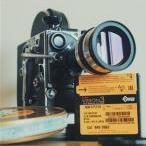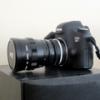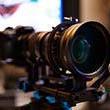
AndreasK
-
Posts
19 -
Joined
-
Last visited
Reputation Activity
-
 AndreasK got a reaction from Cosimo in Some Galileo action going on
AndreasK got a reaction from Cosimo in Some Galileo action going on
Didn't see this topic before. Beautiful images as always and I love you chat with Mr Dan Sasaki!!
-
 AndreasK reacted to Caleb Genheimer in Some Galileo action going on
AndreasK reacted to Caleb Genheimer in Some Galileo action going on
It’s worth noting that the new Rapido Technology FVD-35NP will allow us to shorten long scopes, reducing the squeeze factor... but also gaining angle of view.
-
 AndreasK reacted to rokkimort in Some Galileo action going on
AndreasK reacted to rokkimort in Some Galileo action going on
Sorry, I did not mean to sound mean. But this is not how internet works, I am free to voice my opinion. I see a BS post and I call it out. OP pretentiously talks about "galilean action" and "horizontal artifacts", yet the images are highly uninspiring home shots with some of the ugliest flares I've seen. Then he proceeds to post lenses that look butchered. It seems he just took a hacksaw to some schneider cinelux lenses, then butchered some other lenses and randomly paired elements until he got a useable image. Using pseudo scientific terms to describe this process does not make it anything different. Just pure lens hacking. Pointless exercise, because no self-respecting DP will use something like this to shoot anything remotely important. Sure, if you want to learn by destroying lenses – go ahead. They don't make them anymore though.
But what really worries me is that I see at least 4 different kids in these shots. I don't know how old OP is, and I don't want to assume their gender, but this is not normal.
-
 AndreasK reacted to tweak in Some Galileo action going on
AndreasK reacted to tweak in Some Galileo action going on
Tinkering with lenses and hacking together stuff is what makes anamorphic fun to me, I think some people totally miss the point of why many of us do it.
-
 AndreasK reacted to Cosimo in Some Galileo action going on
AndreasK reacted to Cosimo in Some Galileo action going on
Cinemoller 1.6X with 50mm f1.4 FVD on 5d3
-
 AndreasK reacted to Cosimo in Some Galileo action going on
AndreasK reacted to Cosimo in Some Galileo action going on
Cinelux front glass/ Moller 32 rear glass 1.6X with Lomo block 75mm on FF sensor.
-
 AndreasK reacted to Cosimo in Some Galileo action going on
AndreasK reacted to Cosimo in Some Galileo action going on
Matching different cylinders glass from different anamorphic scope is equivalent of a cylindrical Galilean telescope running backwards, finding a match with different systems that meet the afocal condition. Here are few prototypes I put together and some sample shots. I hope you like, thanks!
.
-
 AndreasK reacted to Caleb Genheimer in Some Galileo action going on
AndreasK reacted to Caleb Genheimer in Some Galileo action going on
I’ve done a decent amount of front/rear group mismatch pairing. What I’ve found is this:
1. you can often find mismatched pairings that function at equivalent quality to their matched arrangement.
2. mismatched pairings are not able to be focused, meaning that they are in focus only at infinity. (This is different from what anamorphic users refer to as “dual focus.” The anamorphic is infinity only just to be clear.)
3. The maximum angle of view is determined by the front element group, and cannot be changed. (Note a key distinction however that the squeeze ratio changes, which DOES change which taking lens focal length will be associated with the unchanging angle of view. This also means that the vertical field of view changes as well.)
4. the source-point flare comes from the rear element group, the secondary mirrored flare comes from the front element group.
To take all of this and give a specific example, let’s say I’m trying out pairings with the front element group from my Kowa 16-H. On my Blackmagic PCC4K, lets say my favorite lens to use with it stock is my Canon FD 24mm, which also happens to be the widest lens I can use if my final delivery is going to be a tasty, vignette-free 2.39:1.
Let’s move on now to the (imaginary) mismatch pairing. I have an old B&L CinemaScope kicking around, and I pair the rear grouping from this scope with the front grouping from my 16-H, in front of my 24mm, which is set to infinity. The B&L elements are nice and cozy right up against the 24mm’s front, but things look blurry. I move the 16-H front grouping in and out until I get a nice sharp image. Neat! If I focus the 24mm on something closer, say, my C-stand at 5’ from camera, I can’t seem to achieve anything sharp no matter what the distance is between the Kowa and B&L element groups. Oh well... infinity it is! (That’s what variable diopters are for anyway, right?)
Ok, so we have our trusty 24mm. We have a Frankenstein of glass from two scopes in front of it, and it’s nice and sharp (at least at infinity,) so what now? Well, let’s shoot a chart, pull some footage into an NLE, and figure out what the squeeze of our new Frankenscope happens to be. A quick stretch of the footage to where the chart looks normal reveals..... 1.75X! Neat! Now, there’s definitely some vignette, but that’s ok, we’re after 2.39:1 delivery. Let’s crop in until the vignette goes away, shall we? The result? vignette free when cropped to 3:1. That’s cool, we could probably go a little wider with the spherical lens.
A quick scour through the camera bag unearths a LUMIX 21mm lens. Let’s ditch the 24mm and try the 21mm. Abracadabra, drop some 21mm footage into the timeline, desqueeze and crop out the vignette: 2.39:1. There now exists a 1.75X scope that can go as wide as a 21mm taking lens! That’s a wider taking lens than the Kowa could handle stock!
Or is it? A meander through the maths:
21/1.75=12mm lens equivalent horizontal
24/2=12mm lens equivalent horizontal
BUT!!! (You may say, and you’re correct) there is no vertical squeeze factor here, so vertically, the 21mm is STILL wider than the 24mm. Yes. You are using a wider focal length lens, but your horizontal field/angle of view remains unchanged. The two scope configurations both are and aren’t equivalent to each other. Oh the joys of anamorphic. This is why anamorphic lenses are said to have two focal lengths (one horizontal and another vertical,) and it’s why we get oval bokeh too!
The final kicker is when we add our variable diopter of choice: an SLR Magic Rangefinder. The stock Kowa is now choked to a maximum of 28mm, and the Frankenscope can only do 25mm. It turns out that in practical application, the limit of all wide anamorphic adapter setups is the variable diopter, not the scope. The new Rapido FVD-35 is right at the limits of the very widest anamorphic adapters. What’s more, a bigger diopter setup to squeeze out those last few distorted degrees of angle-of-view would be laughably gigantic. The FVD-35 is 134mm in diameter. That means it already sits only 2cm above a 15mm LWS rod setup, so unless you want to go full 19mm studio rods and use 6.5X6.5 mattebox for filtration, the FVD-35 will do “just fine.”
Why, then, would anyone bother to Frankenscope? Well, because lenses are so much more than the numbers. Even by the numbers, you might prefer a novel squeeze ratio. You might want beautiful mixed gold and teal flares. You might want the thick, lush flares from an old scope with some added sharpness and contrast from one more modern. You might want a unique look, that’s all your own, completely custom. Besides that, the experimentation is really fun!
A quick look at remotely reasonable anamorphic offerings reveals: Xelmus has a 40mm and Atlas has a 32mm, both of which only cover a standard 35mm open gate. The FVD-35 is right in this ballpark in any case. Unless you find an exceptionally rare 22mm LOMO, or rent some top shelf glass, you’re not going to go wider... never mind that depth of field becomes so deep when this wide that the differences between spherical and anamorphic are difficult for most people to differentiate. As someone who hacked scopes apart to try and go wider, here’s my conclusion: do what works for you, but you’re gonna need a big variable diopter, because that’s the bottleneck. After that, find your wide scope of choice, Frankensteined or stock, it’s just preference.
I had some awesome results from very humbly priced pairings. I bought a half dozen or so scopes off eBay, and did my level best to spend $100 or less on each. A great trick is taking big/long adapters meant for 35mm projection, and pairing their front element groups with rears from shorter 16mm projection scopes. As a general rule, this seems to significantly shorten the scope’s length, and reduces the squeeze factor. There are a plethora of theoretical 1.8X, 1.75X, 1.5X, and 1.33X custom scopes out there for anyone with the willpower and funding to go on a mix and match bonanza.
-
 AndreasK reacted to Vladimir in Some Galileo action going on
AndreasK reacted to Vladimir in Some Galileo action going on
im in. this is from 1.6x scope, first test with 50f2:
-
 AndreasK got a reaction from PepperJay in The Bolex-Anamorphot 16/32/1.5x thread
AndreasK got a reaction from PepperJay in The Bolex-Anamorphot 16/32/1.5x thread
Thanks, I only bought it recently from ebay seller Mario Gorlas (die_bitsbox http://www.ebay.de/usr/die_bitsbox?_trksid=p2057872.m2749.l2754). He had it serviced by a former film technician. They met each other at WDR station, where he also used to service analog film cutting tables. He's also familiar with anamorphics and now services all of Marios lenses.
I would not know how to open the Bolex but I can tell from my recent experiences with the Rectimascop that front and rear elements are correctly aligned (...that's the case if the horizontal flares of front and back lens are parallel and the image is perfectly sharp also if you look directly through the lens). The Rectimascop is a great lens to learn such things as it's very simple to disassemble. Also the focus marks of the Bolex hit precisely.
-
 AndreasK got a reaction from SigurdW in The Bolex-Anamorphot 16/32/1.5x thread
AndreasK got a reaction from SigurdW in The Bolex-Anamorphot 16/32/1.5x thread
Thanks, I only bought it recently from ebay seller Mario Gorlas (die_bitsbox http://www.ebay.de/usr/die_bitsbox?_trksid=p2057872.m2749.l2754). He had it serviced by a former film technician. They met each other at WDR station, where he also used to service analog film cutting tables. He's also familiar with anamorphics and now services all of Marios lenses.
I would not know how to open the Bolex but I can tell from my recent experiences with the Rectimascop that front and rear elements are correctly aligned (...that's the case if the horizontal flares of front and back lens are parallel and the image is perfectly sharp also if you look directly through the lens). The Rectimascop is a great lens to learn such things as it's very simple to disassemble. Also the focus marks of the Bolex hit precisely.
-
 AndreasK reacted to ken in The Bolex-Anamorphot 16/32/1.5x thread
AndreasK reacted to ken in The Bolex-Anamorphot 16/32/1.5x thread
Yes, IMO, if you have different 2X anamorphic lens and not plan to sell again. It is easy to combine them as different ratio anamorphic lenses you like.
Like your Rectimascop 48/2x front lens with ISCO integrated rear lens, you will get a 1.3x or less ratio.
-
 AndreasK got a reaction from ken in The Bolex-Anamorphot 16/32/1.5x thread
AndreasK got a reaction from ken in The Bolex-Anamorphot 16/32/1.5x thread
I have a Bolex Moller 16/32/1.5x for sale together with a special clamp from rapidotechnology. It's performs great with edge to edge sharpness and I bought it only recently but surprisingly my new 1.5x lens which I made from a Rectimascop 48/2x front part and the rear element of a Schneider Cinelux 2x delivers very similar results (except the very far edges). Anyway, here is the link to the ebay auction: http://www.ebay.de/itm/RARE-Moeller-Moller-16-32-1-5x-Anamorphot-Anamorphic-Cinemascope-/272477606381 I can also add a 72mm filter adapter in order to mount a Rectilux CoreDNA to the front
Another thing is that I plan to offer my anamorphic attachments and taking lenses as rental items but now I'm a little afraid to rent such an expensive lens out. The Bolex also doesn't work well with my longer Lomo OKC 75mm taking lens, while it works nicely with the shorter lomos. The lomo lenses compose a small set (35mm, 40mm, 50mm and 75mm for the moment), are converted to Arri PL and are intended to be my main rental taking lenses as they could be used with an Arri Alexa in LCS mount. The Bolex seems to work really well with the Nikon 85mm f1.8 as longer lens, though: https://www.flickr.com/search/?text=16%2F32%2F1.5x%20Bolex
-
 AndreasK got a reaction from nahua in 3-axis camera stabilizing systems – Overview
AndreasK got a reaction from nahua in 3-axis camera stabilizing systems – Overview
Last week we used our new Porta Head 5 system for the first time with the cablecam and the brushless gimbal brought another improvement into the stabilization together with the kenyon gyro we used before. I edited some footage and making-of-material from the shooting with the cablecam. The camera used was a Canon 5D Mark 3 in RAW modus. Focal length mainly used was 50 mm, some shots used 35 mm and up to 85 mm.
Best regards,
Andreas Kielb
http://www.portahead.de -
 AndreasK got a reaction from Ian Anderson in M�VI set to revolutionise filmmaking - Vincent LaForet shows gyro stabiliser by Freefly Systems (with footage from GH3 and 1D C)
AndreasK got a reaction from Ian Anderson in M�VI set to revolutionise filmmaking - Vincent LaForet shows gyro stabiliser by Freefly Systems (with footage from GH3 and 1D C)
Active image stabilization is great in the meantime. But imagine the MöVi or a similar device on a shot of this kind (starting 1:45 min): http://www.youtube.com/watch?v=sYFXv6bDIY8#t=1m45s
Soy Cuba is from 1964 but still a classic with extraordinary shots.The camera was handheld and passed from one operator to another or connected to cablecam trollies ascending from street level, through the building and at the other side again on a cablecam and above the street. Thogether there were two flights with cablecam systems and the rig was connected with a magnet to the trollies for fast coupling. I would use carabiners for higher safety and together with my cablecam I can imagine to get something like this done. The stabilized third axis would also help on the cablecam to point the camera correctly and being stabilized like in the MöVi video.
Here is some additional information about the movie: http://www.rogerdeakins.com/forum2/viewtopic.php?f=2&t=850
-
 AndreasK got a reaction from Wit in M�VI set to revolutionise filmmaking - Vincent LaForet shows gyro stabiliser by Freefly Systems (with footage from GH3 and 1D C)
AndreasK got a reaction from Wit in M�VI set to revolutionise filmmaking - Vincent LaForet shows gyro stabiliser by Freefly Systems (with footage from GH3 and 1D C)
Not all steadicam builders and operators missed brushless technology. I'm part of a german open source community, testing and building brushless systems since a few months. Somebody there showcased a DIY gimbal that looks exactly like the handheld MöVI:
http://www.imagebam.com/image/e4b9a5247306171
http://fpv-community.de/showthread.php?24682-MoVi-Freefly-Brushless-Gimbal-goes-Hollywood/page2
I did also notice how good this system is for handheld usage, though it is only 2 axis at the moment. But the third axis is on it's way:
http://fpv-community.de/showthread.php?24620-Offizieller-Thread-Brushless-Gimbal-Controller-f%FCr-3-Achsen (...sorry, everything in German).
I'm building a 2 meter crane version for my steadicam very similar to the Portocam or Steadicam Tango. Should be ready to show first results soon :). Once the 3 axis controller is available I'll add handles for handheld as well. Brushless systems are also great for shotmakers and car mounts like this guy shows: http://www.youtube.com/watch?v=wWRKXHPSCls.





